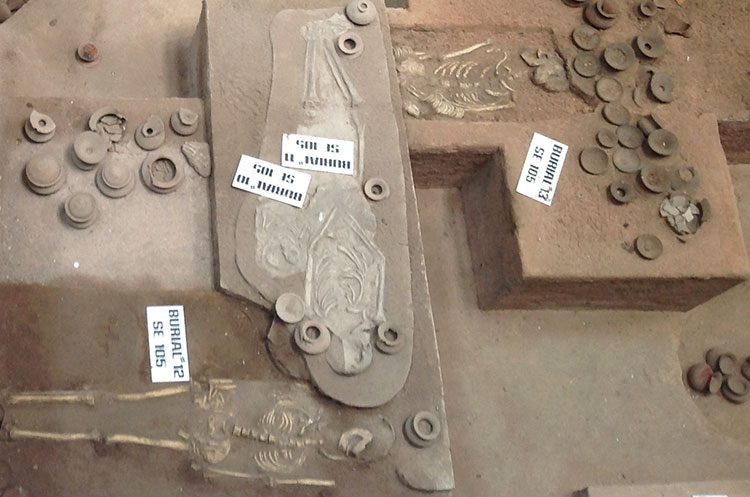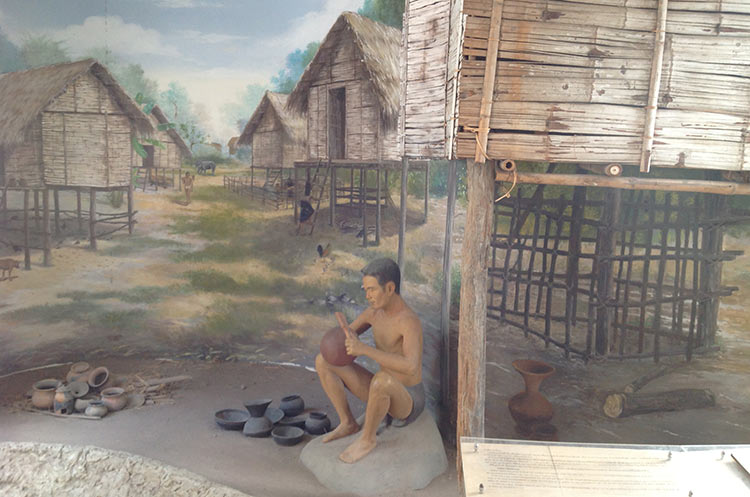
Ban Prasat Prehistorical Site
Bronze and Iron Age burial site
Ban Prasat is a prehistoric site near the banks of the Than Prasat river in the small village of Ban Prasat, Nakhon Ratchasima province. About 3,000 years ago people settled the area. They grew rice and raised domesticated animals.
The site was excavated in 1991 by the Thai Fine Arts Department. Three pits have been dug out. Burial sites containing a total of 60 graves were found where skeletons of male, female and children were unearthed as well as offerings buried with them. The oldest graves date back to the Bronze age, about 1,000 BC. The latest graves are from the Iron Age, which started around 500 BC. The dead were buried with offerings of pottery vessels and jewelry, such as shells and marble bangles.
Other finds made indicate that the area was also occupied during the Dvaravati era (6th - 11th century) and the Khmer era (12th - 14th century). Today the village is still inhabited.
Three excavation pits
Three pits a few hundred meters apart have been excavated. Each one is covered by a modern structure to shelter it from the elements. An information board at each pit provides information about the finds that were made.
Pit number 1 measures 4 by 10 meters. It is found at the center of the site, next to the information center and museum. Pit number 2 measures 4 by 4 meters and is found in the North West part of the site. Pit number 3 is located in the South West part of the site. It measures 4 by 6 meters.
Burial practices
The dead were buried face up in rectangular graves. Over the centuries burial practices changed, such as the direction the head of the buried were pointing to and the burial goods that accompanied the dead.
During the first phase, the dead were buried with the head pointing to the South East. Archaeologists believe that the ankles were bound. Most of the time offerings consisted of pottery vessels, sometimes also jewelry items as seashells and bangles.
Burial practices during the second phase were similar to those of the first phase, except that there was no specific orientation of the body. Most of the graves are without ornaments. Small children were buried in a large jar.
During phase three the orientation of the body was towards the East. Funery vessels were intentionally smashed, the pieces were placed around the body.
The fourth and last phase took place during the Iron Age. The dead were buried with the head pointing to the North. Burial gifts were black funery vessels known as Phimai Black Ware, bronze ornaments and glass beads. Rice grains were placed near skull and body.

Ku Than Prasat Mound
Ku Than Prasat Mound is found to the North West of the village. During excavations of the earthen mound a number of objects was found including a bronze ax, a container used to melt metal for the production of tools, pieces of glazed ceramics, a Dvaravati style Buddha image and two skeletons buried with bronze ornaments.
Unfortunately, the site has been looted and badly damaged in the past. Very little remains of an ancient structure named “Ku Than Prasat”.
Information center and museum
Next to excavation pit number 1 is a small information center and museum. Here visitors will find a diorama of what the village looked like in prehistoric times, information about how people lived as well as a map of the archaeological site and info about the excavation pits. The museum contains displays of pottery excavated at the site and several skeletons.
How to get to Ban Prasat prehistorical site
Ban Prasat archaeological site is located in the village of Ban Prasat, about 1 kilometer North of Highway 2. The village is found in Non Sung district, about 45 kilometers Northeast of Nakhon Ratchasima town.
Opening hours
The site opens daily from 8 am until 5 pm.
Entrance fee
Admission is free.